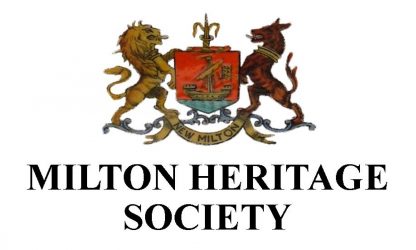The Railway Station was for many years the centre of New Milton since it was built in 1886. It was not just passengers using the rail network. The goods yards and sidings were one of the main ways to bring in and out of the town large items or large quantities of goods. Bricks from the Gore Brick Company and from the Milton Brick Company were made in New Milton and taken by rail to Bournemouth and elsewhere for building use.
There was a coal yard in the sidings as it was easy to bring in this type of fuel and dump it straight from the train wagons into large wooden bunkers (made of old railway sleepers) for resale and delivery. This easy method of bringing the coal into New Milton brought about the rise of a number coal merchants operating in Station Approach.

This image is a 1910 advert for Alexander Mason who was a coal merchant and haulage contractor based in Old Milton as well as Station Approach. The photograph shows the method of storage and of weighing coal that was used at that time.
At the top end of Station Approach opposite the Milton Hall (now a pine furniture shop) there were several huts. These huts were effectively small shops where a Miltonian could go to order coal. They were situated on the right of Station Approach roughly where the entrance to the metal footbridge starts. The huts are visible in this aerial image of the top end of Station Road taken in the mid 1920s.

One coal company was Fraser and Whites. However the main coal merchant in the 1920s and 30s was ‘Stocky’ Read. His office is still located in the station yard and was until recently in use as the Galleon Taxi Office.

This 1931 image shows the coal yards in the background and Stocky Read’s office to the left with an advertisement board above the roof. Later this office was used by George Stickland as part of his newsagents business. All of the newspapers for the New Milton area were brought in by train in a large bundle. George would divide them up in the hut and ensure they were delivered to the various shops. It is of note that one of the railway sidings ran up to the rear of this hut. With three railway sidings in use there was a need for a signal box to control the rail traffic movements in and out of the sidings and onto the mainline. The signal box was located at the end of the London bound platform. It was demolished in the 1967 when the sidings were closed down. Also on the London bound platform was a large W.H.Smith kiosk which sold newspapers, books and sweets to passengers about to embark on their journeys.

It can be seen in this 1960s photograph taken from the footbridge.
Animals from local farms were also transported by rail. There was a wooden pen in the station yard in which the animals were herded prior to being placed on specially constructed cattle trucks for onward delivery. Milk from the various dairy farms around New Milton would have been transported in churns by train to larger towns such as Bournemouth or Southampton.
The area around the Railway Station was starting to be developed. The 1932 Ordnance Survey map shows Whitefield Road has houses on nearly every plot. Avenue Road is in the process of development on the north side of the street. Most of the shops have been built south of the Unionist Club (now Conservative Club) in Station Road. After WW2 the Hants and Dorset Bus Company had an office in the station yard as seen here in this 1961 dated photograph.

Note where the bus is in the photograph. Just to the rear of the double decker there was a small waiting room for bus passengers.
A company called Cater Paterson operated a delivery service from the station. Large parcels would be sent by train rather than todays van delivery. Carter Paterson operated a fleet of three wheeled delivery vans which would take the bulky packages, suit cases and packing trunks from the train to the final, local destination.
The railway sidings were eventually closed down in 1966 and the signal box demolished a few months later. With the loss of the sidings the coal yards also closed. The area where this industry once operated has now become a car park. However business ventures still carry on in Station Approach. As already mentioned the Galleon Taxi company operated from Stocky Read’s former office and a car and van rental firm do business from the area between the railway and the entrance to Station Approach.
The railway station and the yard beside it has had a busy working life and looks set to continue to do so for the foreseeable future.
